Dick Ernst discusses the SAFE Act and its impact on the Manufactured Housing Industry, and the extent of a potential boost from FHA financing
Reporter Eric Miller with Publisher L.A. ‘Tony’ Kovach for MHMSM.com
We conclude the interview begun last week with Dick Ernst.
MHMSM: You just mentioned the SAFE Act. How is that being viewed from inside the mortgage industry?
ERNST: There is lots of confusion. More so, probably, for the manufactured housing business. In the mortgage business, it’s pretty straight forward. I think for the most part, mortgage brokers are being squeezed out because you can’t do the yield spread premiums, charge higher rates to customers with more money going to the broker and things like that. So I think the mortgage brokers are being really squeezed on the mortgage side of the business. But it’s pretty straight forward for the mortgage business. If you operate under a national charter – if you’re a national bank, credit union or thrift – you have to register your people; your people don’t have to be licensed. But the people who go out there and originate loans for you have to be licensed within the state they are doing business with, so you’re dealing with someone who is going to be regulated.
In the manufactured housing business though, it’s much more confusing because of the nature of our business – with some of it being mortgage-type transactions and a large part of it being chattel financing. There are some issues related to the SAFE Act that really make it confusing, in my view, for the average retailer. But in that situation, I believe, the way our business has historically been handled using a retail installment contract or a three-party contract, I think that’s going to be very problematic for the industry going forward because that, technically, makes the dealer a lender and then he assigns that loan to another lender, usually at par value. So, I think that’s going to be problematic and I think our industry is still trying to figure out the right way to handle it.
Community operators, those that we just talked about, that are actually investing in their own paper – I don’t think there’s any question that they are lenders. They are deriving benefit because they are collecting interest on the loan they are providing to the customer. All the other issues related to the administrative aspects of what a retailer does, those to me become more secondary to the bigger issues of, are you getting benefit by earning interest on the loans you are making? Are you, in fact, utilizing a retail installment contract, which represents a loan contract that you are taking to the borrower and then assigning it to someone else? I think all those things are more important issues.
MHMSM: Is becoming licensed difficult? Would that possibly serve the customer better if some of the people in the industry did become licensed?
ERNST: Becoming licensed for people who are involved in the mortgage business is like becoming licensed to begin with, passing your mortgage broker’s license. You have to have certain training and understanding of the mortgage lending laws and what you can do and what you can’t do, and what truth in lending is, or [Real Estate Settlement Procedures Act] RESPA is; the various applicable federal laws and state laws and things of that nature. So you already have a background in it and familiarity with it and you have studied for it to pass your mortgage broker’s license. It’s more difficult for our industry, because typical retailers are not that heavily immersed in mortgage lending and, from what I am told, many of them do have difficulty in passing that license, or passing that test to obtain a license because they are dealing with something they haven’t done before. So I think for our industry, it’s going to continue to be problematic. But if you step back about eight or ten paces from this thing and take a big-view picture of that and say, “Is the customer going to be better-served by having someone who is licensed handling or involved in their loan transaction?” I think the answer is, yes. The real question is: what does mortgage lending have to do with doing a chattel transaction?
TK: Let me jump in here and follow up on the SAFE Act issue because a lot of what we heard at the DC meetings was the shear costs of meeting the SAFE Act requirements. I remember the Texas Association executive director saying that a quick numbers crunch with some of their people came up with a cost of 12 million dollars for licensing, and some small lenders figure it’s going to cost them two million dollars to meet all the requirements. You want to touch on that for a second, how that impacts the industry?
ERNST: From a lender’s perspective, doing business in this industry: Take a company that does business in multiple states. They have to actually have people licensed – anyone who touches that loan transaction, helps to either set payments or underwrite or establish terms on that loan – is going to have to be licensed within that state. Because every state now has their own SAFE Act they were required to put together. So if you have someone operating in multiple states – and let’s say you have loan officers who may get loan business from five, six, seven, eight, nine different states – they’ve got to pass the licensing for all of those. And so the compliance – and I heard one of the major lenders in our industry talk about their expenses like you say – that compliance, that licensing – that’s looking at every aspect of your business to make sure you are doing things properly, because compliance is their second largest expense after personnel. It becomes very costly, because the penalties for violating SAFE Act requirements or regulations can be severe. I think the big fear that most of the industry has is that because of the economic situation, you may have states that see this SAFE Act as a potential revenue generator for them both through the licensing fees as well as the audit fees, and potentially the fines and penalties that might be imposed and collected.
MHMSM: But most state laws are based on the national model, right?
ERNST: They are, but keep in mind, the national model – there’s no final rule that’s been published yet. It’s questionable whether a final rule will be published because the responsibility for the SAFE Act is being transferred from HUD over to the Consumer Protection Bureau, and whether HUD is going to ever issue a final rule or not is in question. Meanwhile, you’ve got states out there that have created their own, based on the information provided initially from the proposed rule from HUD; and keep in mind, those were minimum standards. So the state law had to at least contain the minimum standards provided for in the national SAFE Act that HUD had published. So you see other states that have imposed other things such as brick and mortar requirements. In other words, you have to have a physical office with someone specifically licensed in that facility where records can be stored, where customers can come in if they wanted to, to address issues, whatever it may be. That becomes a very expensive proposition. And then you begin to look at states and say, “Well, how much business am I getting out of there anyway and can I justify having an office there; and if I can’t, then I am going to pull out of the state?” So you’ve got all of those issues. And when you talked earlier about the cost for some, it’s, “What do I have to do to be in compliance in those 46 or 48 states or whatever it may be that I am operating in?”
MHMSM: Right. I could see where that would add to the cost substantially. You once served as interim President for the MHI – when was that?
ERNST: Back in 1998, the last of the big years when we had 373,000 shipments that year. The issues the industry faced then were significantly different. MHI had been trying for a number of years to pass the Manufactured Housing Reform Act, if you will, that addressed issues like installation and licensing and inspections and things of that nature, that really brought some significant issues and updated the HUD code, so to speak. The industry battled and we had conflicting views with MHARR and we couldn’t get anything done. In fact, we had Congress people tell us, “You guys better get your act together before you come back in here because we can’t have divisive opinions from both of you. We don’t know which way to go on this thing, so you better get your act together if you expect to get any help on this at all.”
That was what I would say was one of the positive things that occurred during that period I did serve as interim president. Walt Young was the chairman at that time and Walt directed me to sit down with Danny Ghorbani and meet with him and see if some of our disagreement wasn’t more personality than substantive and if we couldn’t both come together and compromise. We did end up coming together. We formed a coalition with MHARR and had a working group of people that worked in lock step, and we spoke with one voice as an industry for the first time in many years. That helped to get the Manufactured Housing Act of 2000 passed.
The question that’s often asked is: How did we face that issue? And I mentioned earlier that we had a third of our business that had below a 600 FICO score. And everyone likes to have an excuse; and excuse or not, there was an awful lot of Wall Street money, there were a lot of things going on at that time in the industry, a lot of consolidations, a lot of acquisitions going on. Champion Homes was very busy acquiring other companies, acquiring a lot of retail distribution networks – chains, if you will, of retail operations – and creating a really intensive, competitive struggle within the industry. You had other companies then trying to stay ahead of the game with Champion and trying to match them purchase for purchase; a lot of Wall Street money chasing the industry saying these securitizations are great, get us more, get us more, and people saw the acquisition of a chain of retail operations as a way to cement their ability to generate a lot of retail paper and more securitizations. As a result, underwriting went away pretty much. I remember lenders were paying as much as five points for a transaction to a retailer – and that’s to buy a 600 FICO score customer – and they were paying the retailer five points. That’s just not sustainable. It all came crashing down. Repossessions started occurring with great frequency and it became very difficult.
MHMSM: It seems to me manufactured housing can now be positioned as quality housing you can afford, unlike the so called site-built McMansions that too many couldn’t afford; but there’s talk the Obama administration may begin to look away from promoting and subsidizing homeownership in favor of pushing the rental housing market. Shouldn’t manufactured housing be positioned as an alternative to both? How can we move our message ahead the most rapidly and effectively?
ERNST: I think it should be positioned and I’ve often questioned in my own mind – you know, we like to claim that we’re the only form of non-subsidized housing. I don’t know if that’s a good thing or a bad thing. It’s always been touted as being a good thing, but at the same time, if you’re not a part of the government’s plans for providing or assisting people with housing, then that kind of puts you on the outside. I agree with you that the industry should position itself as a home that you can afford. You don’t always have to rent. But I think, and this is just a personal opinion, I still think that we’ve got to improve our image, and perhaps even the architectural appeal of our homes, so that they are more broadly accepted by what I will call the traditional home buyer. I think there are people who look for manufactured homes or who buy manufactured homes because they think that’s the only thing they can afford. At the same time, those same people may have had a manufactured home before or maybe currently live in one.
So I think that we’ve got to broaden our appeal. I think that we’ve got to offer good quality affordable lifestyles, whether it’s in a land-lease community or provide an architecturally comparable home for someone who wants to put it on a piece of real estate. And I think until we do that and can get the opportunity for urban and suburban placement of homes, because architecturally they are compatible with all other homes, I think that’s when we’ll begin to see a broader acceptance and a broader capability of maybe doing suburban developments with homes that just happen to be built in a factory, but they look like everything else.
MHMSM: You mentioned urban. I haven’t heard of many instances where there’s any of that. Is that a potential market for manufactured housing?
ERNST: There have been situations. In California, in Oakland and other places; there was one, I think, in Louisville and in Maryland and other places where non-profit groups actually did urban infill projects where there are a bunch of empty lots; and they had to change the architectural characteristics of the home for them to be compatible with surrounding products.
Also in Cincinnati; I remember Dan Rolfes did the project in Cincinnati. He worked with the mayor and several manufacturers and they did some gorgeous homes. Some of them were modular and some of them were manufactured. None of them looked like a mobile home. They all looked like houses and they were very compatible; they were really a little bit nicer than their surrounding properties, because it was in a much older area of the city. The experience from those has been that those homes have appreciated; they were very favorably priced, and it provided a place where young professionals could purchase a home, be close to the city, be close to the ballparks – that type of thing – without having to commute 30-40 miles.
MHMSM: Is there anything else you would like to share?
ERNST: I do want to clear up and offer what I think are some potential positives. The industry can get mired down in negatives pretty easily. We’ve been mired in negatives for a long time. I really think there’s an opportunity to have good open dialogue and meeting with people, at least at FHA, which I think could be a critical component of the whole finance picture for our industry. If we have a source, an insured source, who consistently… now just think about this for a moment. If we have a source, even with some tightened underwriting through the existing FHA guidelines, that will permit lenders to do the 620 to 660 or 680 FICO score customer, you could have local banks, you might even have regional banks or others, make those loans where they are not participating in the market at all. I think that ultimately then, that will help the over-all industry because I think it will make available an insured loan product. And I think that’s an important part of it, too, because if you have community banks or someone like that making a loan that’s insured by FHA, if they do have to repossess the home, then their loss will be contained to an affordable loss as opposed to one that might be fifty percent of the unpaid balance.
I’ve worked with community banks, and once a board of directors sees a loss where you might lose 50 percent of an unpaid principal balance on a particular home, the next action is, “We’re not doing any more of those.” So I think this could open the door for some portfolio lenders who say, “Ok, I could do a couple million dollars worth of those, or five million dollars worth of those; we’re going to be insured, and we can still buy decent quality paper in there if we service it properly.” That’s one thing. And we mentioned to FHA that I think it would be very helpful if the industry and MHI in some way could help FHA create some sort of an educational program for new or prospective lenders in the Title I program, and even Title II, to educate them about our industry and about our home products and give them the tools they need to be successful in it. We don’t need any more failures in this business.
TK: I agree with that. You kind of touched on something indirectly right there if you’ve got an extra minute. Part of what FHA was setting up was this “ten million dollars plus ten percent.” What do you see happening to that?
ERNST: Well, I personally thought it was an overreach, that it was excessive. Because some of the best lenders in the industry, those that have been successful – and I’ll use Triad as an example – while they may meet the ten million dollar net worth requirements, the additional ten percent of all the outstanding securities that they issue is very onerous. Because if you operate in 45 states or however many they operate in, and if you did an additional 300 million dollars a year in FHA business, that’s an additional 30 million dollars in net worth that you’ve got to have. So now all of a sudden, your net worth requirement goes up to 40 million. That’s just too onerous. What we tried to do is demonstrate to them that that’s not necessary. We went back to them and said no, the average loss on these homes for the lender, while it may not be ten percent – it’s more like 15 percent.
There are some capped expenses that FHA has: they’ll only pay $1,000 per section to move a house (it may cost $1800 per section to move it); they’ll only pay seven percent commission on the sale of a repossession. You know, seven percent on a $50,000 deal is not a lot of money, and you’re sure not going to get a lot of people interested. The standard is more like ten percent, so there’s additional exposure for the lender.
If their actual loss experience is fifteen percent, the ten percent additional is still an overreach. It’s up to us to prove that’s what the lender’s actual loss exposure is. Vicki [Bott] commented that their data reflected that it was closer to 30-40 percent; I think that’s what she said. Well, if it’s 30-40 percent, then there may be a reason to have those excess net worth requirements. I don’t believe that they are. And the unfortunate thing [about those statistics] is that really, the only the only people involved in FHA Title I financing have been Vanderbilt and 21st Mortgage to any degree over the last five to seven years, and they haven’t done a lot of it. Everything else they have is so old and really not even applicable to today’s marketplace and the way people do business. And there’s more of a distressed marketplace situation. I don’t believe it’s appropriate to use those numbers or that they are applicable, but we’ve got to be able to demonstrate that we’ve got some more recent history and some more recent data that says it’s closer to 15 percent. Then we can demonstrate that maybe they can relax the rules to some degree. I’m also working on some other things that I’m not at liberty to talk about that might be another approach on that.
TK: One last question after the one last question. How much of a bump do you think a successful FHA program would represent to the industry in terms of shipments? We’ve seen a lot of numbers on that. What would your take be?
ERNST: Well, I know there’s a lot of disagreement with this and people are going to say, “He’s nuts.” I think there could be a 10-15 percent bump in shipments. That’s 5,000-7,500 shipments, because of the ability to reach the heart of the industry’s customer, the 620-660 or 680 FICO score customer. That being said, there are a lot of other things that have to be right in the marketplace, too. Right now in a lot of areas, we’re still seeing excess inventory of site built homes, a lot of foreclosed homes, a lot of deep discounts on those properties – and that still represents competition. And we’re still looking at a lot of uncertainly in economic times. That’s keeping people from being [at] the sales center and looking to buy. Another important point is that there are going to be a lot of homeowners out there who have the scar on their credit reports of having had a foreclosure. If everything else – income, job stability, all the rest of the situation – is good for a customer, how is FHA going to look at that? We don’t know.
TK: That’s a great point. Dick, thank you so much. Eric do you have anything else?
MHMSM: No, that was a lot of great information.
TK: I want to really thank you personally for your time and all this expert insight. It was very valuable and I think the industry will appreciate it.
ERNST: Well you’re welcome and I hope it’s helpful and I hope you don’t get too [much] criticism of it.
TK: A little bit of criticism is a good thing. I think this is going to be well-received and just outstanding material. Thanks so much.
This concludes our three-part series of an Exclusive Interview Report with industry consultant and once interim-president of MHI, DICK ERNST.



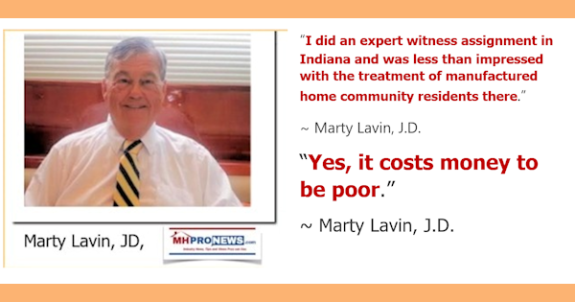
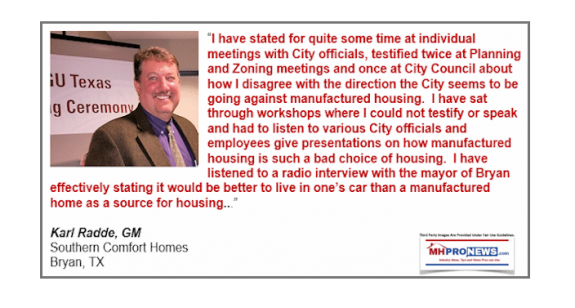
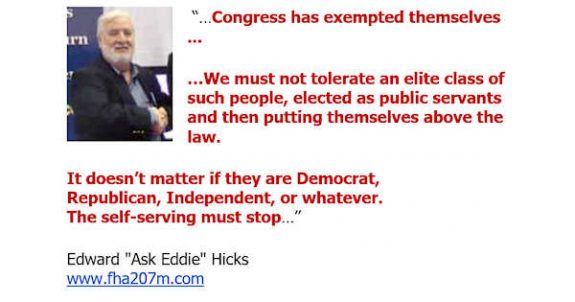
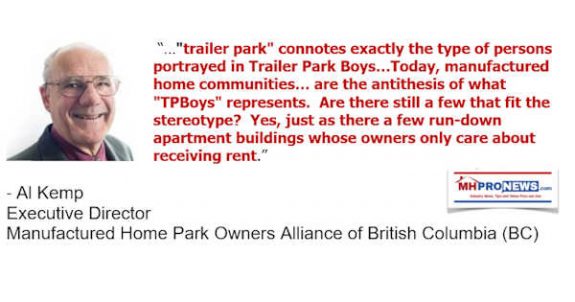
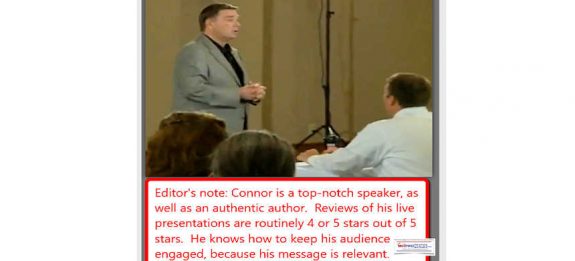
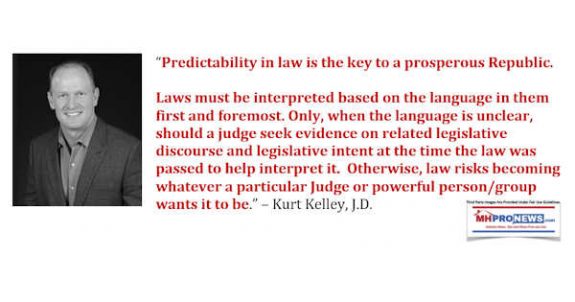
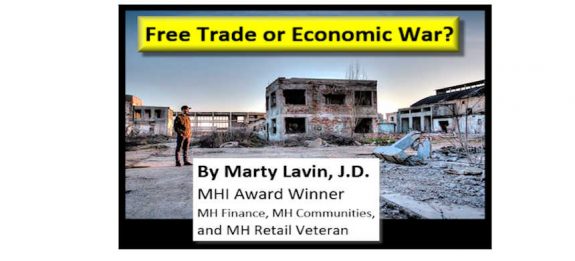
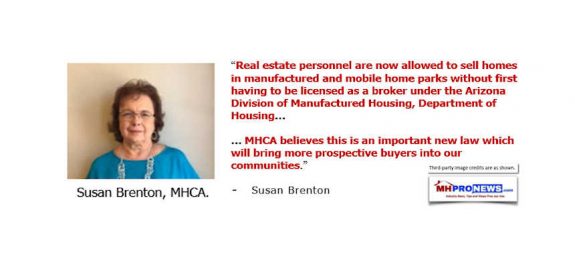
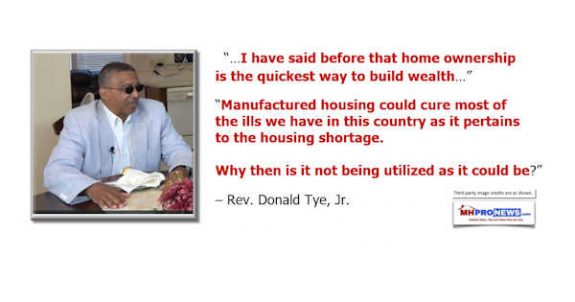
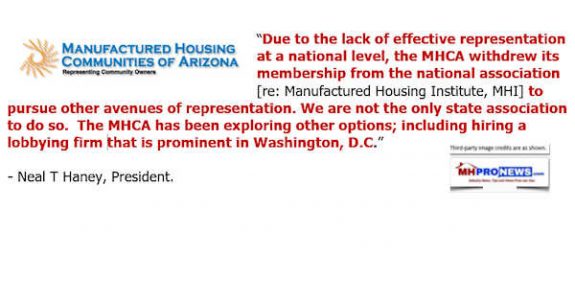
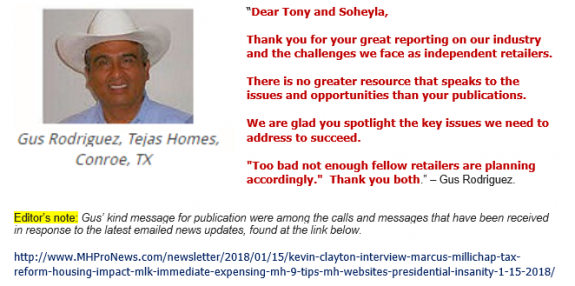
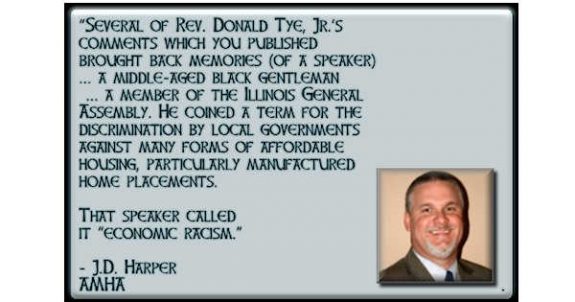
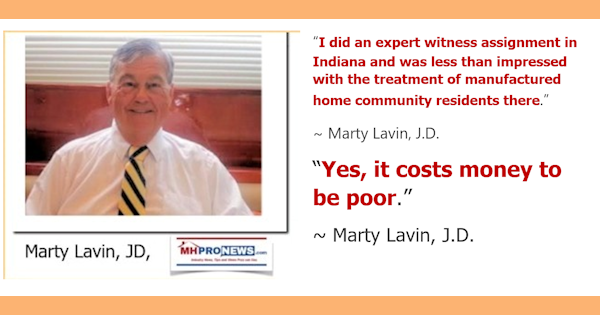
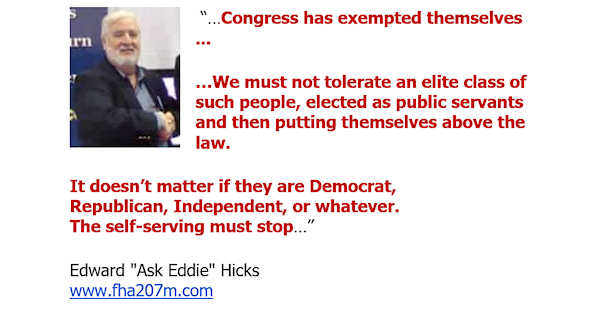
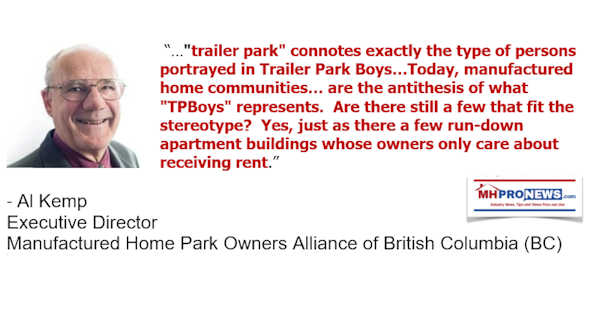
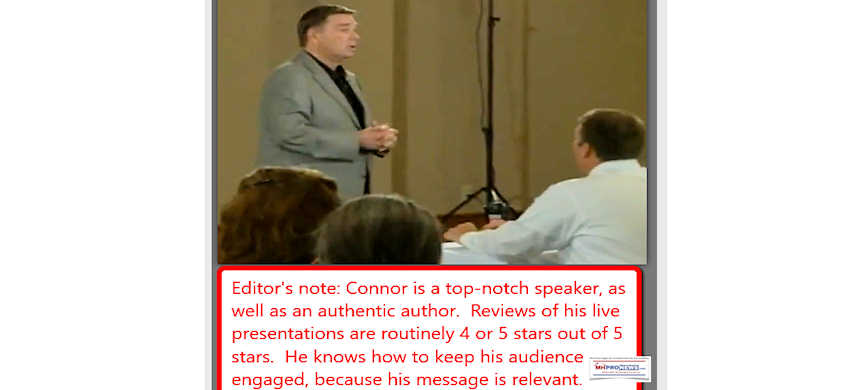
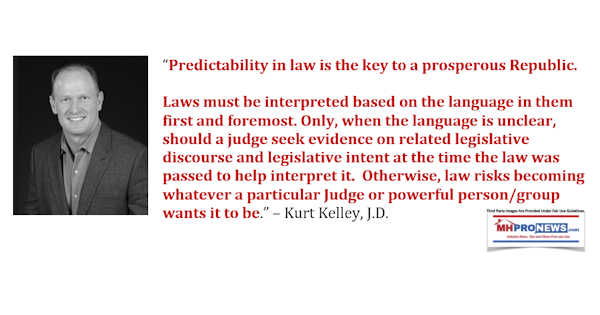
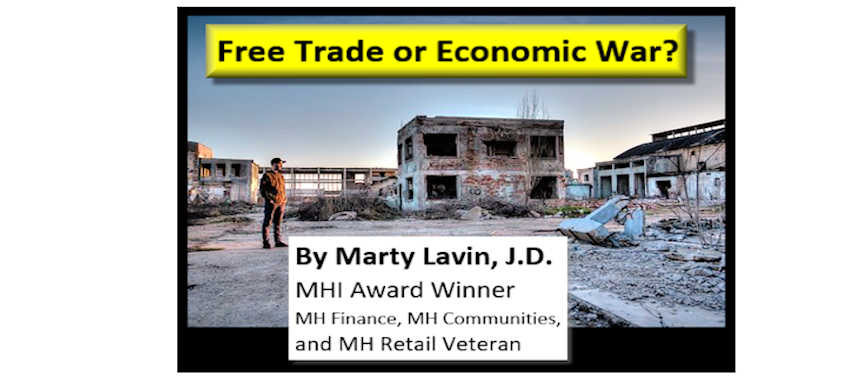
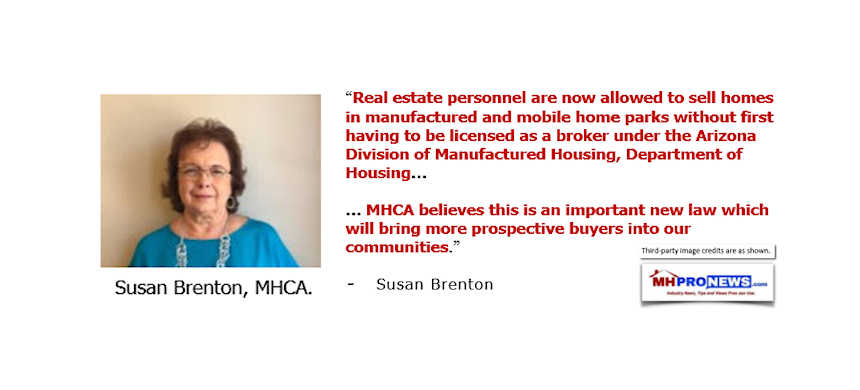
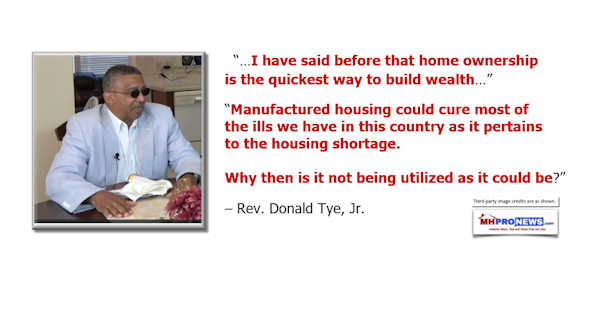
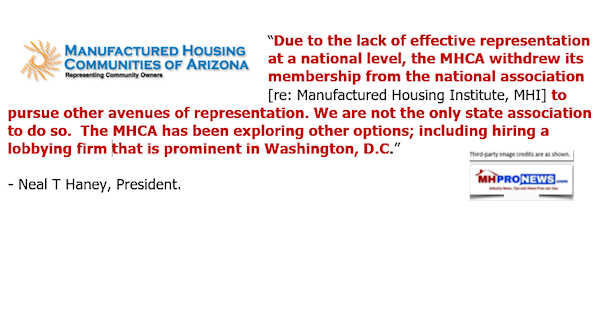
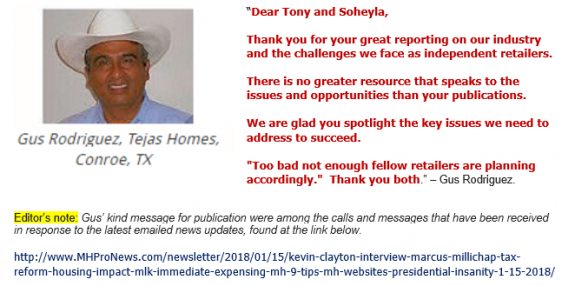
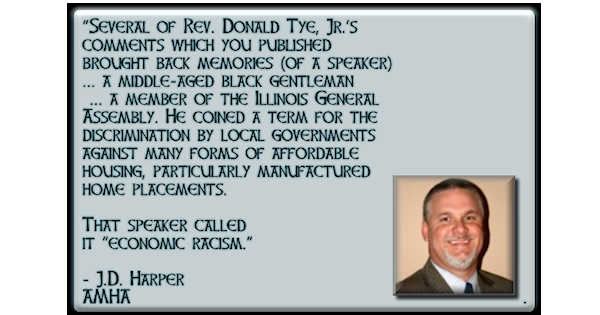
Karl Radde – TMHA, MHI, Southern Comfort Homes – Addressing Bryan City Leaders, Letter on Proposed Manufactured Home Ban
To All Concerned [Bryan City Officials, Others]: As the retail location referenced by Mr. Inderman, I would like to take a moment to address the …